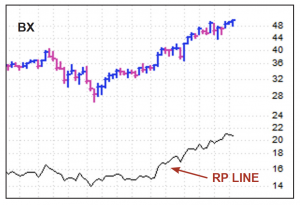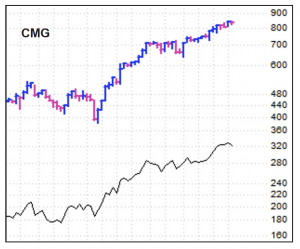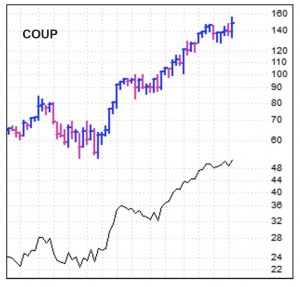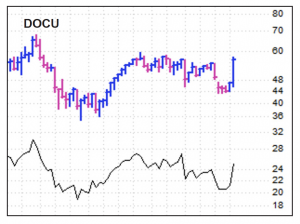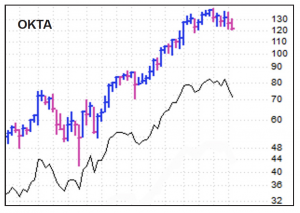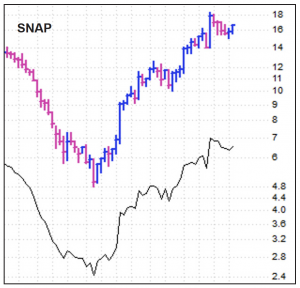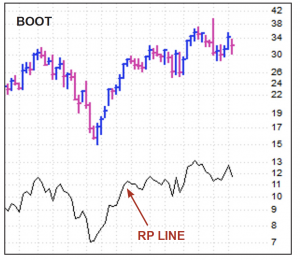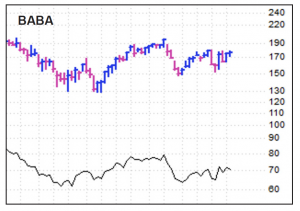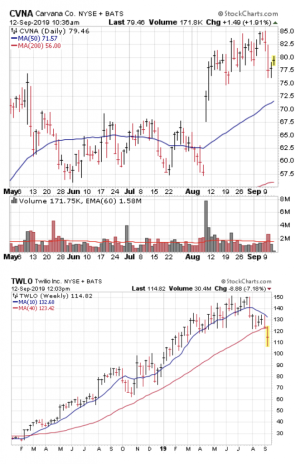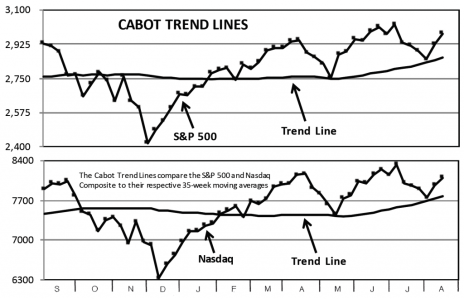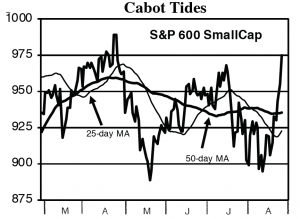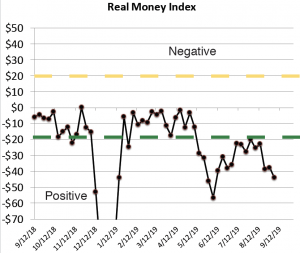The market has been wild in recent days, giving investors very mixed messages—on one hand, many leading growth stocks have broken down, but on the other, the broad market is strengthening, with our Cabot Tides actually flashing a new green light. Given the crosscurrents, we’re taking things on a stock-by-stock basis, selling stocks that are cracking support and looking for new buys among fresh leadership.
Cabot Growth Investor 1428
[premium_html_toc post_id="186415"]
Mixed Messages
The market is never easy to read, but the past week has been about as confusing as you’ll ever see. On one hand, leading stocks have been taken to the woodshed. Software and cybersecurity, which were two of the best performers this year, have been hardest hit, but really, just about any stock or sector that’s enjoyed a good run this year has faced the wrath of sellers.
On the other hand, the broad market is improving. Our Cabot Tides actually flashed a new buy signal on Tuesday! Throw in surging advance-decline lines, some rare power from formerly lagging small-cap indexes (three straight daily gains of more than 1% on accelerating volume) and a plunge in the number of new lows (six straight days of 20 or fewer) and the outlook for the general market has brightened in a big way
How do you invest in this upside-down world? We go into some deeper thoughts on playing the rotation game on page 6, so be sure to give that a look. First, though, remember to keep your feet on the ground and stick with the general plan—keep losses small, take some off the table if a stock acts abnormally, and, on the buy side, look for legitimate setups (not just something that’s jumped the past few days).
For the moment, we’re content to mostly watch and wait. History tells us that, when the market has this many crosscurrents, sustained runs become difficult in individual stocks; you’ll often see money slosh back and forth viciously for a while, often depending on the daily headlines. Plus, of course, many leading stocks have cracked, and there’s a chance the selling could spread to the rest of the market.
That said, our positive trend-following indicators are not to be ignored. Combined with the aforementioned bullish breadth measures and months of horrid sentiment, it certainly bodes well for the major indexes and broad market in the weeks and months ahead. When it comes to the indexes, we still see the next big move being up.
All in all, despite this week’s kick to the gut, we still have a relatively positive mindset about the overall market. But, when investing, timing is vital; right now, we’re watching to see if and when the crosscurrents settle down, which would be a sign that the spastic action is over and big investors are picking up shares.
[highlight_box]WHAT TO DO NOW: In the meantime, we’re taking things on a stock-by-stock basis. Since last week, we’ve sold the rest of our Okta (OKTA) and taken partial profits in both Coupa (COUP) and Chipotle (CMG). But tonight we’re adding a half position in DocuSign (DOCU), which looks like a new leader. Our cash position will now be around 39%.[/highlight_box]
Model Portfolio Update
“Stocks take the stairs on the way up and the elevator on the way down” is a popular Wall Street saying and, as this past week has shown, it’s absolutely true. Thankfully we came into this tsunami with 31% in cash, but we’ve still taken on water this week and thus, taken some action, selling one-third of two winners (Coupa, Chipotle) and dumping the rest of our OKTA.
However, with our trend-following timing indicators both bullish, we’re not sticking our head in the sand—we’re going to nab a half position in DocuSign (DOCU) in tonight’s issue, which will leave us with around 39% in cash. We’re not opposed to more buying going forward, but as we wrote on page 1, we want to see some of the vicious crosscurrents settle down for a few days before putting much money to work.
Current Recommendations
BUY—Blackstone (BX 52)—BX tagged a new high today, so compared to most stocks that have had good runs, it’s still in great shape. While this stock will obviously be pushed and pulled by the market, we remain optimistic that four underlying fundamental trends will keep buyers interested: 1. It’s still a bull market, which will help asset values of all types; 2. Bargain interest rates will only help real estate, which is one of Blackstone’s largest cookie jars; 3. The C-Corp conversion in July dramatically increased the number of potential buyers; and 4. Blackstone’s shift to more dependable fee-based income (up 24% in Q2) is boosting the predictability of the firm’s cash flows and, hence, dividend payments. A drop all the way down to the 43 to 44 area would change our thinking, but right now it certainly looks like the stock wants to head higher. Try to buy on dips of a point or two.
BUY A HALF—Carvana (CVNA 80)—CVNA finally succumbed to the rotation earlier this week, with a big-volume decline as investors took profits. But really, the chart looks fine, with the stock still within its post-earnings gap range (75 to 85 or so). Fundamentally we think the story is as good as ever—this month, the firm opened its second vending machine in Los Angeles (and 21st in the U.S.), which is an attraction that’s been shown to boost engagement in business. And the firm also entered three more cities in Tennessee, putting Carvana in 141 markets, which is within its year-end goal (140 to 145). Because of the story and the fact that the stock looks early-stage (just broke free from a year-long base), as well as the fact that we have “just” a half-sized position, we’re willing to give CVNA plenty of rope (probably into the upper 60s) before cutting bait. And, on the upside, should the market settle down and this stock push to new highs, we could look to average up. Right here, if you don’t own any, we’re fine starting with a half-sized position and seeing how things go.
HOLD—Chipotle Mexican Grill (CMG 806)—CMG’s smooth uptrend was ravaged on Tuesday, as the stock plunged more than 50 points due to the market environment and a labor lawsuit from New York City. As we wrote in Tuesday’s special bulletin, we doubt the lawsuit is going to affect business or be some major distraction; the city is seeking $1 million, which, even if it’s replicated by a few others, is small potatoes. Thus, the company will be just fine. But the company is not the stock—CMG has had a giant run this year, breaking out around 500 and rallying to 850 or so before this drop. It’s unlikely that this is a major, long-lasting top, but like many growth stocks that have enjoyed solid runs, the overall picture points to a period of consolidation. We already sat through one tedious correction in May, so this time we chose to book partial profits (selling one-third of our position) and will give our remaining shares room to breathe, likely down into the lower 700s if need be.
HOLD—Coupa Software (COUP 136)—This stock looked ready to get going following its fantastic quarterly report, but the cloud software sector went from stud to dud starting last week, and Coupa got caught up in the riptide, prompting us to take partial profits (selling one-third of our shares) on Monday. However, not all is lost here—COUP is definitely one of the more resilient in the group, hanging around its August range. And why shouldn’t it? The company has the makings of an emerging blue-chip; we think it could be another Salesforce.com in the sense that Coupa’s spend management platform becomes the gold standard, adopted by thousands of large- and mid-sized organizations. Thus, we still favor giving the stock as much rope as possible, down to our cost basis near 123. Above there, we advise holding your remaining shares.
BUY A HALF—DocuSign (DOCU 63)—In the stock market, fundamentals are obviously important; a great story and growth is what entices big investors toaccumulate big positions. But timing is also important, as the same fundamentally strong company can be weak for months only to get going as perception improves. DocuSign looks like a good example of this. The story has always been hard to beat: The company is the leader in the e-signature industry, which saves companies huge time and money compared to paper-based contracts (50% of transactions completed in less than 15 minutes; $36 average savings per transaction). Yes, there’s some competition, including from giant Adobe, but this is a $25 billion industry and once customers sign up, they stick around and boost their usage (DocuSign’s same-customer growth is around 12%). Moreover, the firm is moving into some ancillary fields, too (document prep, etc.), boosting what it calls its Agreement Cloud offering. Sales growth has been both rapid and consistent in the mid 30% range and earnings are regularly in the black, but some early-year competition fears and a slowdown in billings brought out the sellers. Last week, though, marked a change in character—DocuSign reported a terrific quarter, with sales growth accelerating to 41%, billings soaring 47%, and while earnings slipped, that was due to some one-time factors. Fundamentally, then, the rapid, reliable growth story is in place, and now DOCU is showing some oomph, with what is likely to be a “double skyscraper” pattern with two massive-volume weeks. There’s still some overhead to chew through, and with growth stocks wobbly, we’re starting with a half-sized position (5% of the portfolio) and using a loose loss limit in the mid 50s.
HOLD—Inphi (IPHI 62)—Our most recent addition, Inphi took a hit along with most other things, and we thought it prudent to place the stock on Hold in Tuesday’s bulletin. But we think it’s acting normally so far—after zooming higher 13 weeks in a row, the stock pulled back eight points from high to low and has bounced solidly since. Fundamentally, the company has been quiet on the news front since reporting earnings on August 1, but it’s in a great position to benefit from the powerful data center upgrade cycle and increased telecom spending on faster networks (including 5G next year). We bought a half position on the stock’s dip to its 50-day line two weeks ago, and the fact that it’s still around that level is a good sign. If you own some, hang on.
SOLD—Okta (OKTA 106)—As opposed to Coupa, Okta went over the falls with its peers—we had taken partial profits in late July and again last week (after earnings), and decided to throw the rest overboard on Monday as it broke support. Bigger picture, OKTA has corrected 27% from high to low and is above its long-term 40-week line, so it’s still possible the stock rounds out a new base. But our general take with most of these highfliers is that, after monstrous advances during the past 18 months, they probably need plenty of time to consolidate and come out of the public’s eye. All in all, we made about 35% on the trade, corresponding to around a 3.5% gain in the Model Portfolio. A disappointing ending, but all in all not too shabby.
BUY—ProShares Ultra S&P 500 Fund (SSO 131)—If you look at a chart of the S&P 500, you’d never guess that there’s been so much tumult underneath the surface—the index calmly consolidated its gains from the prior two weeks and, today, nearly moved out to new highs! More important to us is that our Cabot Tides have turned bullish, telling us that the intermediate-term trend has joined the longer-term trend on the upside. It’s always possible the crosscurrents could put a dent in the major indexes, but we’re just going with the evidence—with the overall bull market reasserting itself, we’re restoring our buy rating on SSO, which moves twice the S&P 500 on a daily basis.
HOLD—Snap (SNAP 16)—SNAP fell with growth stocks earlier this week, with a report from one analyst that downloads of the firm’s app were down 18% from the prior quarter. We don’t think the news is that bad; Q2 brought a surge in downloads thanks to some new features, and Q3’s figure is still up 23% from a year ago. Overall, SNAP’s been tedious, but we still view it as early stage (the first breakout came in June, while the low was back in December of last year), and the stock is holding above its prior low near 14. Throw in a powerful turnaround situation and the fact we already have a large amount of cash, and we’re inclined to hang on, let the stock wiggle around and, ideally, resume its major advance. If you own some, sit tight.
Watch List
Elastic (ESTC 94): We swung and missed with Elastic a couple of months ago (half position) as the market yanked it down. Now, however, the stock has shown three straight big-volume weeks of accumulation. The story (and growth) remain excellent.
MasTec (MTZ 63): MasTec is a construction firm, but serves many growth-oriented industries, has a huge backlog and business has accelerated recently. See more on page 7.
Novocure (NVCR 80): NVCR has fallen sharply during the past three weeks with other growth titles, but we’re not giving up on it—it’s given up about half of its May-August advance, which isn’t abnormal in our book. See below.
Shake Shack (SHAK 101): We’ve always liked the story here, with a rapid store expansion plan for the firm’s roadside-like burger joints. After a couple of years of up-and-down action, SHAK changed character in August when it soared on earnings. A couple weeks of resting or retreat could offer an opportunity.
Other Stocks of Interest
The stocks below may not be followed in Cabot Growth Investor on a regular basis. They’re intended to present you with ideas for additional investment beyond the Model Portfolio. For our current ratings on these stocks, see Updates on Other Stocks of Interest on the subscriber website or email mike@cabotwealth.com.
Boot Barn (BOOT 35)—We’re always on the lookout for solid, cookie cutter stories, and Boot Barn has a good one. The company is the leader in a growing retail niche: It’s the top seller of blue-collar work wear and western-style clothing and accessories. As the name suggests, about half of sales are footwear (boots or rugged footwear), with one-third apparel (denim, western shirts, outerwear, even flame resistant shirts for work!) and the rest hats and accessories. Longer-term, the trends here are strong as the popularity of country-style living and culture increases, and, business-wise, it’s a positive that, because Boot Barn’s products have a relatively low fashion quotient, discounts are a rarity, which helps margins and avoids inventory issues. It’s not changing the world, but Boot Barn addresses a huge and growing market that should produce years of solid growth if management continues to pull the right levers. The firm ended last year with 240 stores (83% of sales occur in-store, with the rest online), should boost that by 10% this year (payback on every new store averages around three years) and there’s no reason the count won’t rise steadily from here. Even better, business is doing great—in Q2, sales rose 15%, with same-store sales up a very solid 9.4% and earnings up a whopping 38%, which was miles ahead of expectations. Analysts see the bottom line up 24% this year and 19% next. As for the stock, it’s been up and down with the sector, but it’s not far from its highs and has a nice launching pad to work from. It’s probably too thin for us ($25 million of volume per day), but we like this story a lot.
Novocure (NVCR 80)—One regret we have this year is not pulling the trigger on a couple of watch list stocks that we were high on. Novocure, which we wrote about on this page back in early July, is a good example, though the good news is that it could be offering up a decent entry point (if growth stocks find their footing). The company’s claim to fame is its Optune system for treating certain types of cancer; it uses electric fields (dubbed tumor treating fields) to non-invasively disrupt cancer cell growth; the system is portable and has shown great results. It’s been approved to treat glioblastoma (a type of brain tumor) and for mesothelioma (linked to asbestos use; just approved in May of this year) in concert with chemo, and there’s been a strong uptake so far, with 2,726 patients using Optune at the end of Q2, up 26% from a year ago, which drove a 41% gain in revenue. With the new mesothelioma indication, analysts see solid growth for the next few quarters at least (revenues expected to rise 38% this year and 33% next, with profits coming in 2020), and the future beyond that should be even brighter—Novocure is conducting trials with Optune in four other types of cancer (preliminary results look good) that will produce important data readouts in 2020 and 2021. Any one of those indications (brain metastases from non-small cell lung cancer would be the first) would boost the company’s target market by many-fold! As for the stock, it had a gargantuan run from its breakout level in June (mid 50s) to a high of 98 last month before sinking a bit below its 50-day line during the recent selloff. Usually the first dip toward that average offers support … assuming the market environment doesn’t worsen. NVCR is on our watch list and, should things stabilize, could be something we start a position in.
Alibaba (BABA 178)—The current market environment is favoring stocks that have gone through the wringer in recent months (or years) and are showing signs that good times may be around the corner. Alibaba looks like a good candidate for a turnaround if Chinese stocks can truly get going. The firm doesn’t need much of an introduction: It’s one of the leaders of the Chinese e-commerce space, and despite that country’s slowing economy, Alibaba continues to post amazing numbers. In Q2, the firm’s revenues leapt 42% in local currency, while US$ earnings galloped ahead 51%, bolstered mostly by its core commerce platforms (654 annual active customers, up 20 million from the prior quarter) as well as its ever-growing cloud operation (revenues up 66% in Q2), which looks a lot like Amazon’s web services division. Bigger picture, the company’s earnings have been relatively flat due to heavy investments during the past year, but that’s starting to change; analysts see the bottom line up 20% this year and 25% next, and our guess is both will prove conservative should global tensions cool and as investment spending levels off. As for the stock, it really hasn’t done badly—it’s basically been range bound between 130 (late last year) and 210 (early last year) during the Chinese bear market, and recently it’s set up a halfway decent-looking base which included a positive reaction to earnings. Is BABA something we’re going to jump on tomorrow? Probably not. But should the rotation persist, we think this stock could re-emerge as a leader given that there aren’t many dominant global companies growing as rapidly as this. A push above 195 would be tempting.
Playing the Rotation Game
In a presentation I gave at this year’s Cabot Wealth Summit that discussed lessons learned over the past 20 years, one of my slides was titled “Rotation—Follow the Plan.” I discussed the fact that, in the old days, most groups moved with the market on a daily or weekly basis—but these days, there are usually a couple of rounds of vicious rotation every year, with one set of stocks (usually cyclical-oriented) moving the opposite of growth stocks.
The example I used was back in late 2016 when, post-election, growth stocks like Facebook were hammered while the big-cap indexes rose and cyclical stocks (financials, metals/mining, transports, etc.) soared. Today, three years later, we’re seeing something similar, as many leading growth stocks of 2019 have broken down while money has flowed back into the broad market.
The question on everyone’s mind is: How do you play the rotation game? We have a few pieces of advice, and we’ll split it into two parts: The sell side and the buy side.
Selling: Hold or Fold?
First and foremost, it’s vital to keep some perspective. For instance, Carvana (CVNA) took a big hit earlier this week when the growth stock selling accelerated, but we’re still holding because (a) the stock is still above its 50-day line, so the overall uptrend is intact, and (b) the stock is, in theory, early stage, having just lifted from a year-long consolidation.
Compare that to Twilio (TWLO), which was a flag-bearer of the bull move in cloud software stocks. But looking at the chart, you see that the stock has come a very long way from its lows early last year, and it broke its intermediate-term uptrend back in early August. (That’s when we sold our remaining shares.) And earlier this week, it collapsed below its 200-day line! Obviously, it’s possible TWLO will bounce following a big decline, while CVNA falls further. But you’ll be in a better place over time if you use some perspective to hold stocks that are pulling back normally, while getting out of those that are flashing abnormal weakness.
On that note, most software and cybersecurity names that led the advance this year look iffy—huge runs over the past 18 months and decisive breaks that look abnormal for at least the intermediate-term. That doesn’t mean some buck the trend (we’re still holding a partial position in Coupa (COUP), for instance), but the overarching point is that the odds favor these names needing time, with some likely not to be leaders again.
Buying: Where to Look
While the past week has been a kick to the gut, there should be opportunities out there if the growth stock selling doesn’t spread—and it hasn’t so far, as the Cabot Tides are now positive and the Cabot Trend Lines are still bullish. But it’s important to stick to the system and not just plow into whatever stock or sector has rallied for the past week.
Right now, there are two types of situations to look for. The first would be a traditional growth stock that’s simply acting well. Example: DocuSign (DOCU), which we’re starting a position in tonight. The stock already had a few bad months (weak hands are likely out) and is now showing power.
The second is a growth stock that is still relatively early in its run but is now pulling back. Example: Insulet (PODD), whose Omnipod insulin pump is producing accelerating revenue and strong earnings growth. The stock broke out in May and boomed on earnings in July but has taken a hit with everything else this past week. If it can stabilize around its current level, it would be a good sign this is just a normal pullback.
And the third would be a stock that has a solid story and numbers but is outside of the traditional growth sector. Example: MasTec (MTZ), which is a construction firm, though we’re not talking about housing or properties. The company is a leading builder of infrastructure, especially in the energy (pipelines and such), electricity generation (including a ton of alternative energy products) and telecom (5G should boost demand) sectors. Business has been accelerating a bit, and management sounded a very bullish tone about the potential of telecom orders in the years ahead, comparing it to where the energy segment was in 2015 before the pipeline buildout took off.
Moreover, the stock itself recently staged a longer-term breakout; MTZ built a huge launching pad from January 2018 through July of this year before gapping to new highs on earnings. It’s not a rocket shot, but it looks like MTZ has begun a new, sustained advance. It’s on our watch list.
Cabot Market Timing Indicators
Market-wise, the picture looks bright—both of the market’s trends are up and sentiment has been in the dumps for months. The trick is with individual growth stocks, which have come under pressure. If the crosscurrents can dissipate, we’ll be looking to put more of our good-sized cash hoard to work.
Cabot Trend Lines: Bullish
The Cabot Trend Lines approached the edge of the cliff a couple of weeks ago, but the rally in the major indexes since then has kept the indicator positive. At last week’s close, both the S&P 500 and Nasdaq closed a bit more than 4% above their respective 35-week moving averages, which means the market’s longer-term trend is pointed solidly up.
Cabot Tides: Bullish
Our Cabot Tides flipped to positive on Tuesday, as all five indexes (including the S&P 600, shown here) are above their lower (25-day) moving average, and that moving average has now begun to advance. The 600, in fact, has been a big beneficiary of the recent rotation, surging higher in recent days after lagging all year. All told, both the intermediate- and longer-term trends of the market are now bullish, which tells you to keep your eyes open for new buys.
Cabot Real Money Index: Positive
Our Real Money Index tells us the same story as many sentiment measures: Investors are at best uncomfortable, if not outright bearish at worst, with a whopping $44 billion gushing out of equity funds and ETFs during the past five weeks. That continues a trend seen all year of investors hunting for safety—a trend that should offer fuel for a sustained advance.
[premium_html_footer]
Send questions or comments to mike@cabotwealth.com.
Cabot Growth Investor • 176 North Street, Post Office Box 2049, Salem, MA 01970 • www.cabotwealth.com
All Cabot Growth Investor’s buy and sell recommendations are made in issues or updates and posted on the Cabot subscribers’ website. Sell recommendations may also be sent to subscribers as special bulletins via email and the recorded telephone hotline. To calculate the performance of the portfolio, Cabot “buys” and “sells” at the midpoint of the high and low prices of the stock on the day following the recommendation. Cabot’s policy is to sell any stock that shows a loss of 20% in a bull market (15% in a bear market) from our original buy price, calculated using the current closing (not intra-day) price. Subscribers should apply loss limits based on their own personal purchase prices.
Charts show both the stock’s recent trading history and its relative performance (RP) line, which shows you how the stock is performing relative to the S&P 500, a broad-based index. In the ideal case, the stock and its RP line advance in unison. Both tools are key in determining whether to hold or sell.
THE NEXT CABOT GROWTH INVESTOR WILL BE PUBLISHED September 26, 2019
We appreciate your feedback on this issue. Follow the link below to complete our subscriber satisfaction survey: Go to: www.surveymonkey.com/marketlettersurvey
Neither Cabot Wealth Network nor our employees are compensated by the companies we recommend. Sources of information are believed to be reliable, but are in no way guaranteed to be complete or without error. Recommendations, opinions or suggestions are given with the understanding that subscribers acting on the information assume all risks. © Cabot Wealth Network. Copying and/or electronic transmission of this report is a violation of U.S. copyright law. For the protection of our subscribers, if copyright laws are violated, the subscription will be terminated. To subscribe or for information on our privacy policy, call 978-745-5532, visit www.cabotwealth.com or write to support@cabotwealth.com.
[/premium_html_footer]



